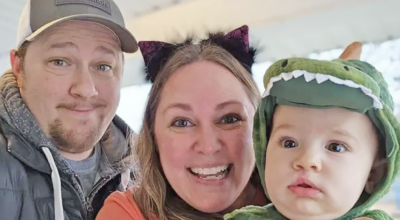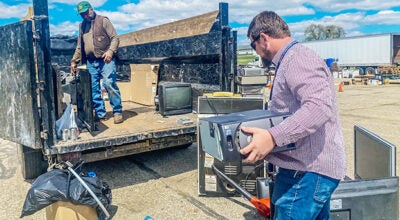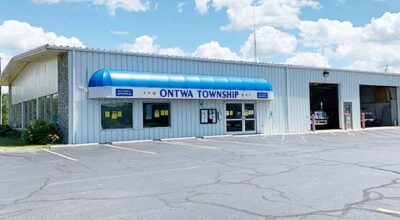Silverbrook Legacies: Your local library – Gateway to your history
Published 8:49 am Wednesday, April 21, 2010

Dale Carnegie supplied $15,000 to build the original Niles District Library - now the Chamber of Commerce building - the final cost of which was $12,403. This picture was taken for its dedication ceremony on Nov. 17, 1904.
By FRIENDS OF SILVERBROOK CEMETERY
The Niles Daily Star continues the historical series on those buried in Silverbrook Cemetery. We join the Friends of Silverbrook Cemetery in welcoming your suggestions for future columns.
Each April, we quietly celebrate National Library Week. Some may revisit old classics last read in public school, while others may choose to discover some new author.
Friends of Silverbrook Cemetery have some special reasons to honor our local Niles District Library. Next to the cemetery itself, it is our favorite place. We would not be able to bring you this column without it.
Niles’ earliest effort to bring a library to the community was undertaken by the Ladies Library Association in 1883, when they “fitted up” a reading room over Chapin and Son’s office on Second Street, south of Main. The Niles Republican reported the First National Bank presented carpeting. Other necessities such as a stove, a walnut and revolving cane seat for the librarian, and a “beautiful glass ink stand” were supplied by the ladies.
Mr. P. Bunbury “rendered the ladies material aid by his donations and assistance while the room was being furnished.” It was open every Saturday afternoon from 3 to 5 p.m.
By 1902, it had come to the attention of the Ladies Library Association that Andrew Carnegie was spreading his wealth by backing the donation of library buildings to a variety of communities throughout the country. The City Federation of Clubs organized a steering committee to oversee the project.
Carnegie agreed to give Niles $10,000 for a library providing a suitable site and proper maintenance be assured by act of city council. In turn the council under Mayor Dr. Z.L. Baldwin set aside a $1,000 annual maintenance fund and appointed the first library board of directors.
The City of Niles then wrote Mr. Carnegie requesting that his donation be increased to $1,500 “if possible.” They made the request because they “could not erect a fireproof structure of the size of building desired.” The architect suggested the increase to make the dream come true. Carnegie agreed “in consideration of the town increasing its guarantee to $1,500 annually.”
The groundbreaking happened Sept. 9, 1903 and a check for $2,000 as the first installment arrived from Carnegie a month later. The cornerstone was laid the first week of November. Construction was completed during the summer of 1904 and the key turned over to the board in mid-August. The final cost of the building was $12,403 and dedication ceremonies were held Nov. 17, 1904.
Miss Orrill Pettingil Coolidge, whose father Orville has been both cited and featured in this column was appointed the first librarian. We think both she and her father would approve of the wonderful facility that feeds this column regularly.
With an increased interest in family histories and genealogy, this region is fortunate to have our library with its excellent Local History and Genealogy Department. The department librarian, Ann Flora, was recently in conversation with a patron about the new television series “Who do You Think You Are?” It was with no little pride she declared, “We can do everything they do right here.”
Flora, who is herself a genealogist, has found her dream job and we benefit from it. Seven years ago she began Local History Genealogy Day, bringing local and national speakers to the library for the enjoyment of residents interested in finding their own roots.
According to Head Librarian Nancy Studebaker, “Usage (of the library) has gone up steadily since 2004 when the customer service survey the library does every other (even numbered) year began. Almost 25 percent of those that come in the door come to use the Local History and Genealogy Department.”
No wonder. Browsing through the 28 very full, four-door filing cabinets that fill the center of the department’s main room, patrons discover a wealth of information filed in the business, history and biography sections.
Here is access to four major paid databases: Footnote, the database of the National Archives; Heritage Quest, which contains the complete set of U.S. federal census images from 1790 to 1930, 28,000 family and local history books, an index of more than 2.1 million genealogy and local history articles and much more; Ancestry, the database often used on the current television series; and the database of the New England Historical and Genealogy Society, which was visited by Sarah Jessica Parker during her search for family history during the series. This database now also includes New York State, not traditionally included in New England collections.
Cards are available, through Flora, listing information about other databases with free access, most notable of which is the Mormon (Jesus Christ of Latter-day Saints) project digitizing their treasure trove of microfilm from around the world. The undertaking was to have taken ten years, but according to Flora they are ahead of schedule due to a wealth of individuals worldwide who are doing an excellent job of indexing the records.
However, do not limit your searches for your own records to the Internet. Our experience has proven that assembling historical information is comparable to putting together a jigsaw puzzle or solving a whodunit. What might at first seem to fit often does not.
Information must be checked and cross-referenced against other references. Our library is the perfect place to do this. Not only is there a wonderfully secluded and quiet study room in the department with wireless Internet access for those bringing their own laptops and the expertise and ready help offered by Flora; but the resources are endless.
Besides those already mentioned, you will find many family history and genealogy how-to helps, magazines and newsletters archived and added by Flora since she came to the department seven years ago. The most used resources are the local newspapers and indexes, which go back to 1835, the cemetery records along with the databases.
There are many CD titles available for research, early city directories, high school yearbooks for Niles from 1913 and for other area schools, Niles church records on microfilm and Michigan and other census records. Reproducible genealogy forms are also available to make your recording of your own history that much easier.
For those who have or inherit old papers and albums and do not know what to do with them, you may want to ask for a genealogical will – a codicil to one’s last will and testament directing that important historical records, including books; paper or computer files; notebooks; correspondence; audio/visual items; photographs and documents, not be destroyed. If no interested party is found to accept them, they can be turned over to the Niles District Library or another institution of record. That way you ensure they will be kept safe for future generations or authors of columns such as this.
Friends of Silverbrook Cemetery meets the third Thursday of each month at the Niles Law Enforcement Complex on Silverbrook at 7 p.m. For more information with regards to memberships and work days to help restore and catalog the monuments contact Friends of Silverbrook Cemetery c/o 508 East Main St. Niles, MI 49120; Tim and Candace Skalla at 684-2455, wskalla@sbcglobal.net; or contact Ginny Tyler at 445-0997, sphinx1974@aol.com.






